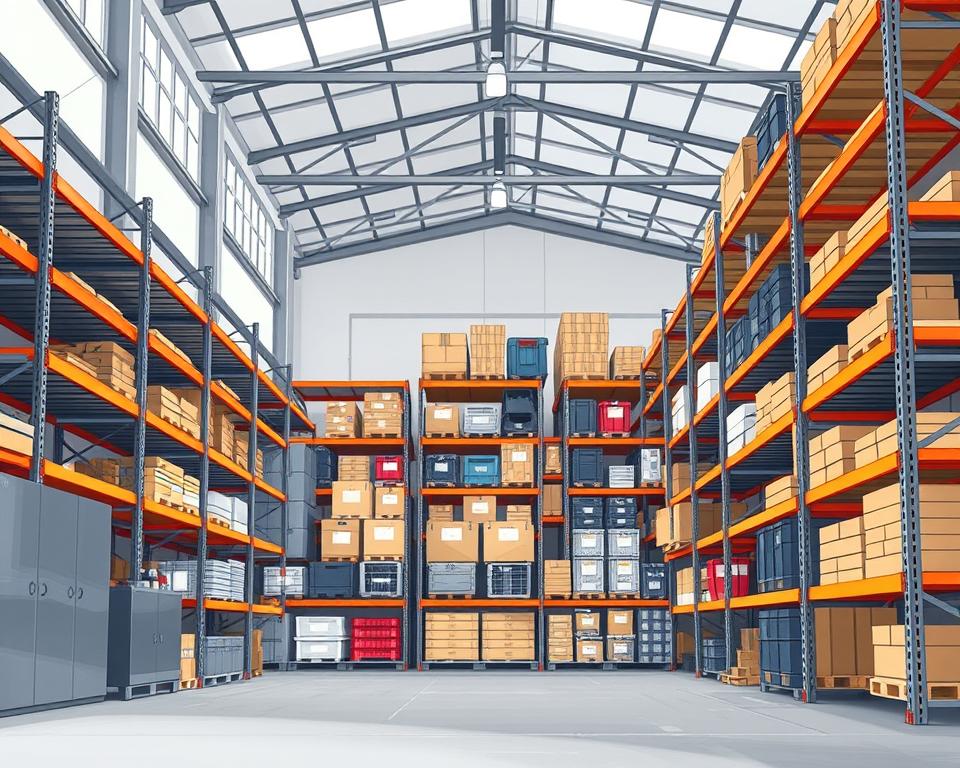Streamlined Stock Control using Rack-Based Storage
In a compact logistics hub near Changi, a lean 3PL crew implemented a major shift. They switched from block stacking to a racking layout overnight. That decision opened up aisles, helped improve driver safety, and shortened the time spent locating pallets.
After several weeks, inventory counts accelerated and costly footprint extensions were avoided. This pragmatic approach suits any operation aiming to maximise space via racking.
Racking systems are designed to transform cubic warehouse volume into organised storage. They help streamline movement and reliable counts for https://www.ntlstorage.com/racking-system-reconfiguration. For Singapore operators, where land is expensive, these systems are essential for efficient inventory storage solutions.
The primary goals of racking systems include optimising storage space, simplifying goods movement, and boosting supply chain efficiency. Benefits span improved equipment access, less clutter and drop risk, flexibility for varied SKUs, and scalable capacity as stock shifts.
Getting racking right blends assessment, layout design, buying, and installation. It also involves clear labelling and staff training. This ensures racking-based inventory control delivers real improvements. It helps defer costly footprint expansion.
What is a warehouse racking system and why it matters for Singapore warehouses
Understanding a warehouse racking system is key for logistics teams to optimize space and flow. It’s a framework of racks and shelves across warehouses, DCs, and industrial sites. It organizes and stores goods efficiently by using vertical space. Effective systems enhance picking speed, inventory clarity, and safety.

Definition and core components
Common parts are uprights, beams, decking, and supports. Together they create bays and beam levels that define locations. It’s essential to match components with load types and adjust as inventory needs evolve.
Racking’s place in modern operations
Fixed locations via racking are critical to efficient inventory control. That speeds counts and improves pick accuracy. Operations often integrate barcode/RFID and WMS to gain real-time oversight. Together they raise throughput and enable varied pick methods, speeding fulfillment.
Singapore context: space constraints and racking
Singapore’s tight footprints make vertical capacity crucial. High-density solutions like drive-in and pallet flow reduce aisle needs and increase storage density. Choosing the right blend preserves selectivity, maximises density, and keeps safety intact.
Racking types and how to choose the right setup
Selecting the correct rack type is central to efficient operations. We outline how rack design shapes day-to-day performance. It compares common rack types, helps match rack type to inventory, and outlines cost considerations for Singapore warehouses.
Common rack types at a glance
The most widespread option is selective pallet racking. It provides direct aisle access to every pallet position. This makes it ideal for high-turnover SKUs and flexible layouts. Costs range from $75 to $300 per pallet position.
Drive-in/drive-thru racks boost density by allowing trucks to enter lanes. They suit bulk, low-variability storage and cut aisle count. Costs range from $200 to $500 per pallet position.
Cantilever racking uses arms to hold long or odd-shaped items such as lumber and pipes. Front-column-free design eases loading. Expect about $150–$450 per arm.
Pushback holds several pallets deep via carts/rails. It raises density NTL Storage while keeping reasonable access to recent pallets. Costs run $200–$600 per position.
Pallet flow or gravity racking uses rollers for FIFO operations. Great for dated or perishable goods. Costs commonly fall between $150 and $400 per pallet position.
AS/RS and robotics span broad cost ranges. They provide high density, fast throughput, and tight WMS integration. AS/RS cost depends on desired throughput, automation depth, and site complexity.
Fit rack types to SKU profiles
Evaluate SKU dimensions, weight, turnover, and handling equipment when choosing a rack. High-turnover SKUs and mixed assortments do well with selective pallet racking or AS/RS that include pick faces. That supports efficient storage and rapid picking.
Cantilever serves long or irregular SKUs. This keeps aisles clear and reduces product handling time. Matching rack type to inventory avoids damage and speeds loading.
For FIFO-critical stock such as food and pharmaceuticals, pallet flow systems keep expiry order automatically. They become a key tool in regulated product management.
Low-SKU-variability, bulk loads benefit from drive-in, drive-thru, or pushback racks. These maximise usable cube, letting teams store more while managing inventory with density-focused racking.
Cost considerations per rack type
Budgeting requires more than per-unit prices. List price is just the beginning. Include install labour, anchors, decking, supports, and safety items. Engineering fees, inspections, and staff training must also be included.
Unit guides: selective 75–300, drive-in 200–500, cantilever 150–450/arm, pushback 200–600, flow 150–400, AS/RS varies. Assess cost considerations per https://www.ntlstorage.com/racking-system-small-warehouses alongside lifecycle costs.
Include slab capacity work, shipping, and any install downtime. Long-term benefits of racking systems in inventory management include improved space utilisation, faster picking, and lower handling damage. These gains often justify higher upfront investment.
| Rack Type | Best Use | Unit Cost Range | Primary Benefit |
|---|---|---|---|
| Selective pallet racking | Fast movers, mixed SKUs | \$75–\$300/position | Full selectivity for speed |
| Drive-in/Drive-thru | Homogenous bulk | \$200–\$500 each | Fewer aisles, higher density |
| Cantilever system | Long/awkward items | \$150–\$450/arm | Unobstructed loading for long goods |
| Push-back | Density with reasonable access | \$200–\$600/position | Multiple pallets deep with simplified retrieval |
| Flow rack | FIFO, perishable stock | \$150–\$400/position | Built-in FIFO rotation |
| Automation (AS/RS) | High-volume automation | Cost varies with scope | Top density, speed, and WMS integration |
Managing inventory with racking systems
Logical fixed locations make tracking easier. Map each SKU to a defined slot from master data. It reduces misplacement and speeds retrieval, enhancing inventory management.
Sort items by speed, dimensions, and fit. Use ABC zoning to place fast movers. Position these items at optimal pick-face heights to reduce travel time and increase order pick rates.
Select stock rotation methods that align with product life cycles. For perishables, use flow racks or strict putaway to maintain FIFO. For LIFO-suitable profiles, pushback/drive-in works well.
Build rack locations into daily control routines. Do rack-level cycle counts and slot audits to fix discrepancies. Post counts to WMS for accurate masters.
Refine paths and staging to reduce travel and mistakes. Match rack height to truck reach and operator ergonomics for safety and efficiency. Teach load ratings, proper placement, clip use, and spacing.
Measure picks per hour, putaway time, cube utilisation, accuracy, and rack impacts. Weekly reviews reveal where to help improve.
Set procedures, train regularly, and use visual controls to enforce rules. Clarity on limits and placement makes control consistent and measurable.
From design to install: key best practices
A robust racking design starts with a detailed site survey. Gather data on SKU profiles, equipment specs, clear heights, column grids, and slab limits. This stage is critical to optimizing space with racking. It supports safety and efficient operations.
Assessment & layout planning
Begin with ABC velocity mapping. Locate fast movers near dispatch in accessible zones. Reserve deeper lanes for slower-moving bulk items. Balance aisle width for safe forklift operation with storage density.
Ensure circulation covers exits, sprinklers, inspection clearance. Involve structural engineers and qualified vendors upfront. This ensures that racking solutions fit the building’s features and comply with local regulations.
Load capacity and shelving load calculation
Calculate shelf loads based on material, shelf dimensions, and support spacing. Use manufacturers’ load tables with safety factors. Confirm deflection limits and per-pallet loading.
Check slab capacity for heavy or point loads. Consult engineers on reinforcement or footings if needed. Label bay capacities clearly and train per-level limits. Routine checks prevent overstress on uprights/beams.
Proper shelving load calculation keeps operations compliant and reduces the risk of collapse.
Checklist for procurement and installation
Use a racking procurement checklist to confirm rack type, bay dimensions, finish, and required accessories. Ensure documentation includes compliance certificates and warranty terms.
| Stage | Key Items | Involve |
|---|---|---|
| Plan | Inventory profile, aisle widths, fire access, SKU zoning | Warehouse manager, logistics planner, structural engineer |
| Engineering | Load data, deflection checks, slab review | Manufacturer engineer, structural engineer |
| Procurement step | Rack type, bay height, finish, accessories, compliance docs | Procurement, vendor, safety |
| Installation step | Prep site, anchor uprights, fit beams/decking, ties | Certified crew, site lead |
| Verify | Plumb/level, clip checks, clearances, signs | QA, safety, engineer |
| After install | Initial engineering inspection, register with authorities, as-built drawings | Engineer, compliance officer, maintenance planner |
Follow installation best practices: clean and level floors, mark bay positions, anchor uprights, and install beams per vendor specs. Fit decking and pallet supports, apply cross-ties and wall ties where required. Verify beam clips and upright plumb, then post visible load capacity signage.
Post-install, train on racking-based inventory control, safe loading, and incident reporting. Maintain as-builts and inspection records for maintenance and upgrades.
Organisation, labelling, and tech for inventory control with racking
Organised racks plus consistent labels cut errors and streamline work. Start with a logical, unique ID scheme for each area. Keep formats picker-friendly and WMS-aligned.
Apply robust barcode/RFID labels at eye level. Labels should include SKU, load limit, and handling info. Standardising label content across the facility enhances inventory control and reduces training time for new employees.
Barcode and RFID scanning expedite cycle counts and real-time inventory updates. Scanning at putaway and during picking ensures stock levels are accurate. It integrates control with WMS and cuts audit discrepancies.
Strategy shapes rack layout. Use zone picking to allocate areas. Batch picking groups SKUs for multiple orders. Wave picking sequences by dispatch waves. Use PTL/PTL systems for fast movers to help improve efficiency.
Optimise pick paths to reduce travel and place high-velocity items near packing stations. Set dedicated faces and lanes for leaders. For perishables, choose flow racks to enforce rotation and cut waste.
Measure accuracy, productivity, and travel. Rebalance locations/allocations based on data. Small, frequent tweaks drive ongoing optimisation.
WMS needs location hierarchy down to positions. Configure hierarchies, strategies, replenishment, and paths. Align digital instructions with physical layout.
Automation and racking systems can significantly increase throughput in high-volume operations. Consider shuttles, AS/RS, or AMRs for dense, fast sites. Integrate automation with barcode/RFID and your WMS for accurate and real-time inventory management.
Keeping racks safe, maintained, and compliant
Safety starts with visible load limits and safeguards. Label every bay with its rating. Install beam clips/backstops/supports to prevent movement. Keep aisles clear and mark egress routes for evacuation.
Routine racking maintenance is key to reducing downtime and risk. Weekly checks for damage, shifts, and anchor problems. Arrange qualified inspections and maintain logs. This helps with audits and insurance.
On damage, lock out affected bays until fixed. Secure anchors, restore clips, and renew labels. A formal reporting process for rack impacts speeds repairs and prevents repeat incidents, preserving inventory management benefits.
Regulatory compliance in Singapore demands adherence to local workplace safety rules and building codes. Reference international standards (e.g., OSHA) where relevant. Train on safe stacking, load limits, and incident reporting. This fosters a safety culture that extends rack life and supports long-term maintenance and compliance.
Frequently Asked Questions
What is racking and why does it matter in Singapore?
Racking is a structural system that maximises storage. It includes uprights, beams, and wire decks. It’s crucial in Singapore due to limited space and high costs. It enables efficient space use, deferring expansion and cutting costs.
What are the core components of a racking system?
Core parts are uprights, beams, and decking. These parts work together to create a structured system. They define bays/aisles for safe, efficient storage.
How does racking help inventory control?
Racking systems improve inventory management by creating fixed storage locations. That yields higher accuracy and less loss. They also enable faster order fulfillment and support real-time inventory tracking.
Which rack types are common and when to use them?
Common rack types include selective pallet racking and drive-in/drive-thru systems. Selective racking is ideal for high selectivity, while drive-in systems are best for bulk storage. Selection depends on SKU profile and handling.
How should I match rack type to my inventory profile?
Choose based on dimensions, mass, and turns. For fast movers, use selective. Use drive-in/pushback for bulk. Verify truck compatibility and aisle width.
How much do different rack types cost?
Costs differ by type and complexity. Selective typically \$75–\$300. Drive-in typically \$200–\$500. AS/RS pricing depends on throughput/integration.
Pre-install planning steps?
First assess SKUs and building limits. Include velocity and aisle width. Bring in engineers/vendors for compliant installation.
How do I calculate shelf loads?
Load capacities depend on shelf material and dimensions. Reference vendor load tables. Always post load limits visibly and verify floor slab capacity for heavy loads.
Checklist items for buying/installing?
Verify type, dimensions, capacity. Include required accessories and compliance documentation. Follow install steps and book inspections.
How should racking be organised, labelled and integrated with technology?
Implement a consistent numbering scheme. Use durable labels and tie into the WMS for live updates. It enables accurate slotting and automated picks.
Which picking strategies pair best with racking solutions?
Use zone picking with selective to boost speed. Choose flow for FIFO. Use automation for very fast movers. Design routes to minimise travel.
How to trade off density vs access?
Let velocity and access guide balance. Selective for fast, dense for bulk. Place fast movers in selective locations and slow movers in dense lanes.
Essential racking safety and maintenance?
Post limits and fit safety gear. Schedule routine checks and fix issues. Maintain clear aisles and emergency egress. Document inspections/repairs for audits/insurance.
What regulatory and compliance issues should Singapore warehouses consider?
Comply with local workplace safety standards and building codes. Engage engineers and registered vendors. Follow recognised rack safety best practices and keep records for regulatory review.
How racking helps rotation and control?
Fixed rack locations help improve accuracy. Use FIFO lanes or putaway rules for stock rotation. Clear zoning/labels aid perishable management.
What KPIs should I monitor after implementing racking systems?
Monitor pick rate, putaway, utilisation. Monitor inventory accuracy and pick accuracy. Use these metrics to rebalance SKU locations and measure ROI.
When to consider AS/RS or robots?
Consider automation with high volume, labour pressure, or tight space. AS/RS and shuttle systems offer high density and speed. Evaluate lifecycle costs and integration before committing.
What are best practices for staff training related to racking systems?
Train on capacity limits, placement, and incident reporting. Provide post-installation training and refresher sessions. Encourage a safety culture where operators report impacts promptly.
Recordkeeping and documentation essentials?
Keep as-builts, load calcs, and vendor tables. Keep logs for inspections/maintenance, certificates, and training. These records support audits, insurance, and lifecycle planning.

